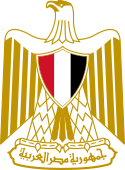 |
|---|
|
|
| Constitution (history) |
| Political parties (former) |
|
|
The Egyptian Socialist Party (Arabic: الحزب الاشتراكي المصري) was a political party in Egypt founded in 1921.[1] The party included both Marxist, Anarchist and Reformist elements. The party platform was published on August 29, 1921. The party began publishing the newspaper ash-Shebiba (الشبيبة). The party established a network of local branches in major cities around the country. It initiated work amongst trade unions and took part in organizing strikes. It also began educational activities for children of workers as well as trying to reach out to mobilize the peasantry.
A party conference held in July 1922 declared the Alexandria branch of the party as the party headquarters. On October 20, 1922, the party declared itself as the true representative of the Egyptian working class. Towards the end of the year the party counted with around 1,500 members (400 in Alexandria).[2]
The party sent Hosni al-Arabi to Moscow, to negotiate a possible entry of the party to the Communist International. Al-Arabi returned to Egypt towards the end of 1921, with the instructions that the party would adhere to the twenty-one conditions of the Communist International. A majority of the party Central Committee (led by al-Arabi) approved the conditions in December 1922, and the name of the party was changed to Egyptian Communist Party (Arabic: الحزب الشيوعي المصري). The party treasurer Rosenthal, who had opposed some of the conditions, was expelled and substituted by Ahmed al-Madani.[2]
In 1923 the party was active in major strike actions. The British authorities clamped down on the party. Many party cadres were arrested and party offices were closed. Anton Maroun, a prominent leader of the party, died in jail. Subsequently, the colonial authorities sponsored yellow trade unions to counter the socialists.
After the crackdown on the party, Marxist sectors continued to operate in cells.
In the 1930s, communist activists participated in the creation of the Committee for the Fight against Anti-Semitism to conduct campaigns against Nazism and organize the boycott of German products. In 1934, the League of Peace Supporters was founded and launched several campaigns to condemn the invasion of Ethiopia by Fascist Italy and to support the struggle of the Spanish Republicans.
Although rejecting Zionist ideology, the Communists supported the United Nations Partition Plan for Palestine and opposed the 1948 Arab-Israeli war. The communists also argued that the main struggle against imperialism was taking place in Egypt and that armed intervention was mainly a way for King Farouk to divert the people from the struggle against the British Empire.[3]
These criticisms led the Egyptian monarchy to intensify its repression of Marxist movements and many activists were arrested. With the arrival in power of the nationalist Wafd party in 1950, the repression was eased. Communists participated in the armed struggle on the Suez Canal against British troops and developed contacts with anti-monarchist officers. Repression did not cease completely, however; thus, Henri Curiel, leader of the main communist organization, the Hadeto (an Arabic acronym for Democratic Movement for National Liberation), was stripped of his nationality and deported. The police, to whom he pointed out that the government had changed with the arrival of the Wafd, retorted: "The government yes, but not the police.[3]
The Egyptian communists were divided when the Free Officers came to power in 1952. Some supported them, like the Hadeto, but others, already suspicious on principle of any military coup, saw the hand of the United States behind Nasser.[3]
YouTube Encyclopedic
-
1/3Views:78 1943 544 199357
-
Weird/Obscure Communist Iceberg
-
Persia before Khomeini - The history of Iran in 15 minutes of perfectly restored film material
-
Galicia and Volhynia (1921-1935)
Transcription
See also
References
- ^ Markaz Al-Buḥūth 'arabīyah Wa Al-Ifrīqīyah. Shahādāt wa-ruʼá al-Juzʼ al-khāmis. Al-Qāhirah: [s.n, 2007. p. 186
- ^ a b Ismael, Tareq Y., and Rifʻat Saʻīd. The Communist Movement in Egypt, 1920-1988. Syracuse, N.Y.: Syracuse University Press, 1990. p. 21
- ^ a b c Gresh, Alain (28 April 2023). "The Passionate Life of an Egyptian – Communist and Jew".
